I'm an artist at heart, performer and songwriter, and a lover of all things creatively & artistically beautiful. In this little corner of the internet, we talk about how to live an artistic lifestyle, fit with the tools, techniques, tips, and community. Get comfy and cozy.
BACK TO THE BLOG
7 simple switches for a nontoxic home (& clearer creative mind)
filed under:
March 14, 2024
created on:
Creating a nontoxic home is a journey I’ve been on for a while now, and let me tell you, it’s always a work in progress.
There’s no such thing as a “perfect” nontoxic home, but every small switch we make brings us closer to a healthier, cleaner space.
There are things that I know now— like the goal of eliminating as much plastic from my house as possible or switching from Mrs. Meyers to Branch Basics— that I wouldn’t have even been thinking about a year ago. And even though it’s quite easy to get down on yourself for not being perfect with it all, take this as your sign that just reading this and striving to improve is a million steps in the right direction.
Here are some simple switches I’ve made— and that I’d recommend— to create a more nontoxic home which in turn will sustain a clearer and more creative mind.
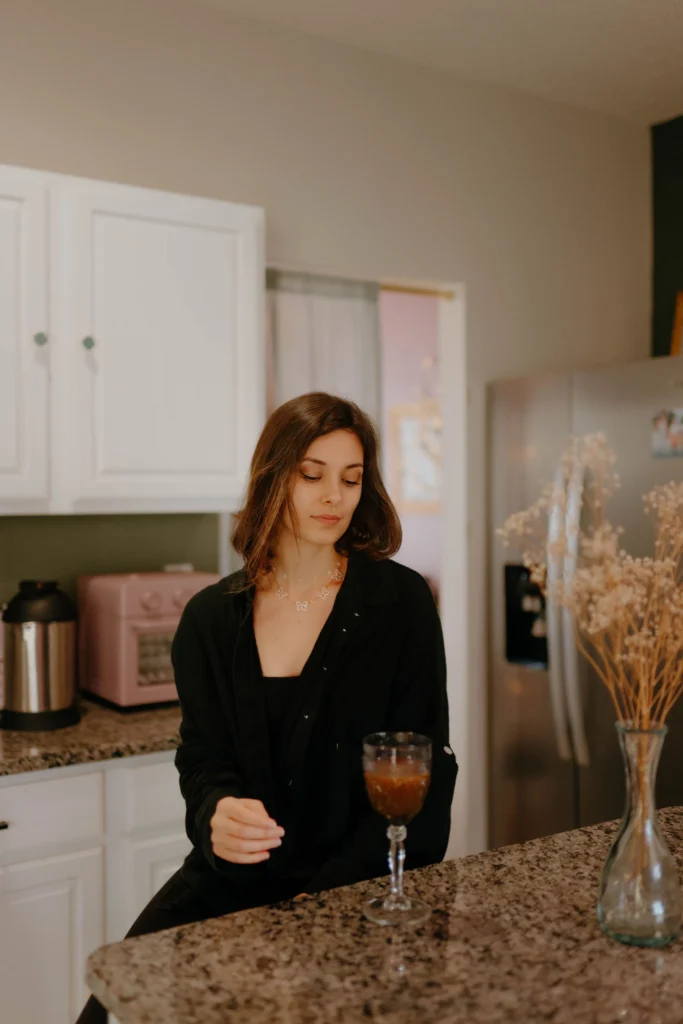
7 Simple Switches for a Nontoxic Home & Creative Mind
1. Toss the Mrs. Meyers & Switch to Branch Basics.
Let’s start with cleaning products. Many conventional cleaning products, like Mrs. Meyers’s, may claim to be nontoxic cleaning products, but they often contain hidden allergens and fragrances. In fact, according to the Environmental Working Group (EWG), Mrs. Meyers Clean Day Hand Lotion in Basil Scent scores a 5 out of 10 on the toxicity scale due to its allergens.
My handmade solutions in the meantime have been 1/2 vinegar, 1/2 water, and 10-20 drops of lavender or tea tree oil. But I don’t love the smell that vinegar leaves when it’s just sprayed.
My friend introduced me to Branch Basics, and it’s honestly been such a great alternative. Their environmentally safe cleaning products for the home are unscented and free from harsh chemicals, making them a safer choice for your home.
The ingredients of the main concentrate are super simple:
Decyl Glucoside— plant-based cleaner
Sodium Citrate— biodegradable salt
Sodium Bicarbonate— baking soda
Sodium Phytate— natural binder
Coco-Glucoside— gentle cleanser from corn, coconut and/or palm
Organic chamomile— flower extract
I went with their cleaning essential kit in glass in my not-buying-plastic era) that includes the Branch Basics concentrate with 3 glass containers that tell you exactly how much water and concentrate to fill each bottle with.
If you do prefer DIY nontoxic home cleaning solutions, you can always stick to the vinegar solution or get a hypochlorous acid machine.
2. Trade Out the Plastic Food Storage for Glass (or Aluminum).
Let’s talk about food storage.
Plastic containers are convenient, but they can also pose risks to your health. Microplastics from plastic containers can leach into your food, especially when they’re heated or exposed to acidic foods. So, we’ve looked to reduce our exposure to plastics by switching to glass containers for our food, drink, and storage (that means trading out those plastic straws from Stanley cups, too).
The right food-safe glass containers are non-toxic, durable, and eco-friendly, especially compared to those plastic containers that have gone through the microwave, dishwasher, red sauce, fork-scraping, and more. (BTW, this is also your sign to ditch your microwave. 
Some cute and safe brands I’ve been eyeing:
- W&P
- Caraway
- Swage
And since we’re talking about plastic, can we say goodbye to plastic water bottles unless 100% necessary? Most plastic water bottles are stored in hot trucks that end up melting plastic into the water.
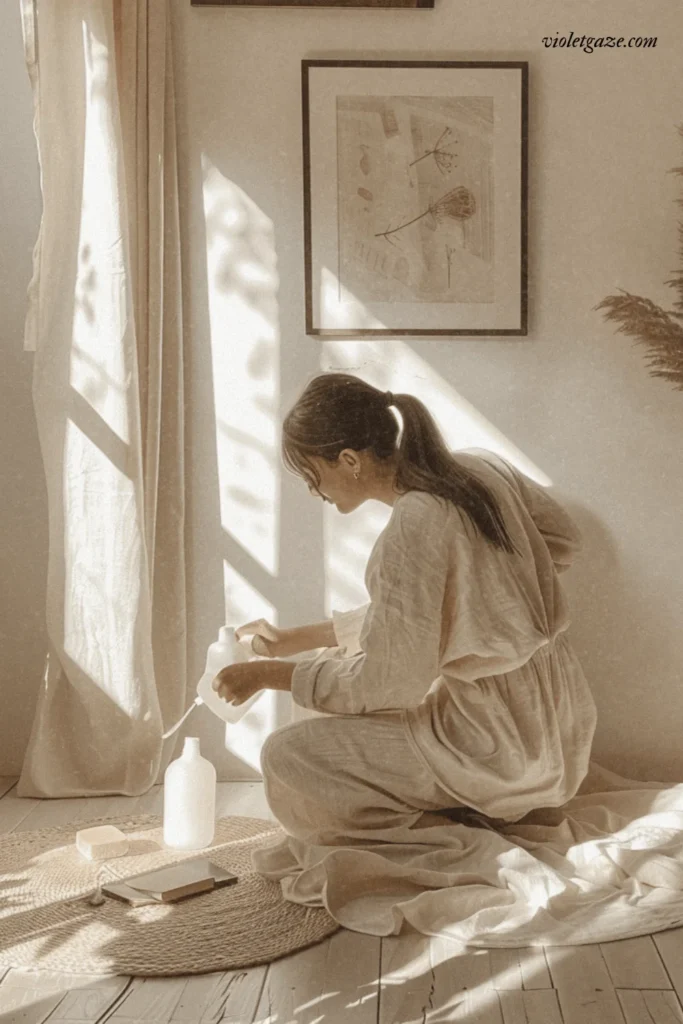
3. Dump the Plug-Ins & Scented Candles for Beeswax & All-Natural Candles.
When it comes to creating a nontoxic home, it’s so important to pay attention to the air you breathe. Synthetic fragrances found in plug-ins and scented candles release incredibly harmful chemicals into the air, contributing to indoor air pollution and releasing VOCs can cause allergies, respiratory problems, and more.




4. Thrift on ThredUp Instead of Buying New.
The (fast) fashion industry is a huge contributor to environmental pollution and waste.
Specifically, it encourages frequent buying of cheap, disposable clothing, which leads to increased textile waste and pollution (this is why I don’t fall into the Temu trap, no matter how convincing those Pinterest ads look! 
Shopping at thrift stores has sooooooo many benefits. Not only can you find unique and high-quality items at a fraction of the cost, but you’re also giving these items a second life, reducing the amount of clothing that ends up in landfills.
I recently ordered my first pieces from ThredUp for a photo shoot and have been super happy with the experience and quality!
To make the most of your thrift shopping experience, here are some tips:
- Look for high-quality materials and well-made items that will last longer.
- Filter from your favorite brands.
- Check for any damage or signs of wear and tear before purchasing.
- Consider altering or repairing items to fit your style or size.
- Donate or recycle clothing that you no longer wear to keep the cycle of reuse going.
You can also reduce waste in your wardrobe by participating in clothing swaps with friends, renting special occasion outfits instead of buying them new, or purchasing new clothing made from sustainable materials like bamboo or hemp. These small changes can have a big impact on reducing your fashion footprint and promoting a more sustainable way of living.
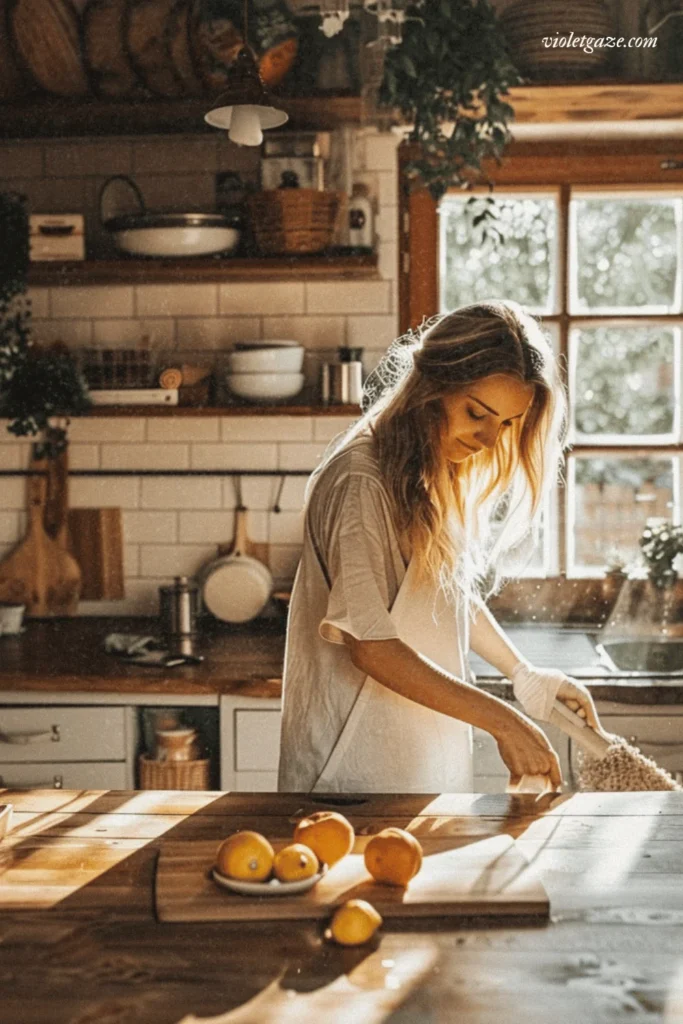
5. Switch to Non-Toxic Cookware.
Nonstick cookware, especially those coated with Teflon, can release harmful chemicals when heated, posing health risks. If you have Teflon, I’d highly recommend switching as soon as possible!
But which alternatives are truly safe when designing a nontoxic home?
Stainless steel, cast iron, and ceramic cookware are all relatively safe, assuming they’re conscious brands, too.
Our Place is our favorite brand for non-toxic, nonstick cookware! Their products are stunning and free from PFOA and PTFE (found in traditional nonstick coatings).
Plus, they’re really easy to clean, which isn’t something I can say with stainless steel and cast iron.
6. Get an Air Purifier.
If you’re like me, you probably walk around the house just wishing the dust could stop! While you’ll still have to clean and dust, an air purifier will help you alleviate pollutants and allergens from the air, creating a healthier indoor environment for you and your family.
We have a HATHASPACE air purifier in a few spaces in our home; it’s especially great to be able to see the air quality right on the digital screen. Plus, since we have 4 cats, there are so many more things that contribute to indoor allergens and dust than if we didn’t.
I’m not the best at keeping indoor plants alive, but I would love to bring in some houseplants to help remove toxins from the air and add oxygen. During a few days in the spring and fall, we can open our windows here in South Carolina to let fresh air circulate and improve indoor air quality.
7. Get a Bomb Water Filter.
So many of us are unknowingly exposed to contaminants in our tap water!
Most regular filters unfortunately don’t cut it anymore— we need to filter out things like arsenic, fluoride, chlorine, heavy metals, pharmaceuticals, and a lot more.
Brita filters are alright, but they’re usually not going to filter a lot of these contaminants, which is why we’ve used the Berkey as renters when we weren’t able to install a filter directly into the sink, as well as the two-stage filter system kit from Healthy Hydration.
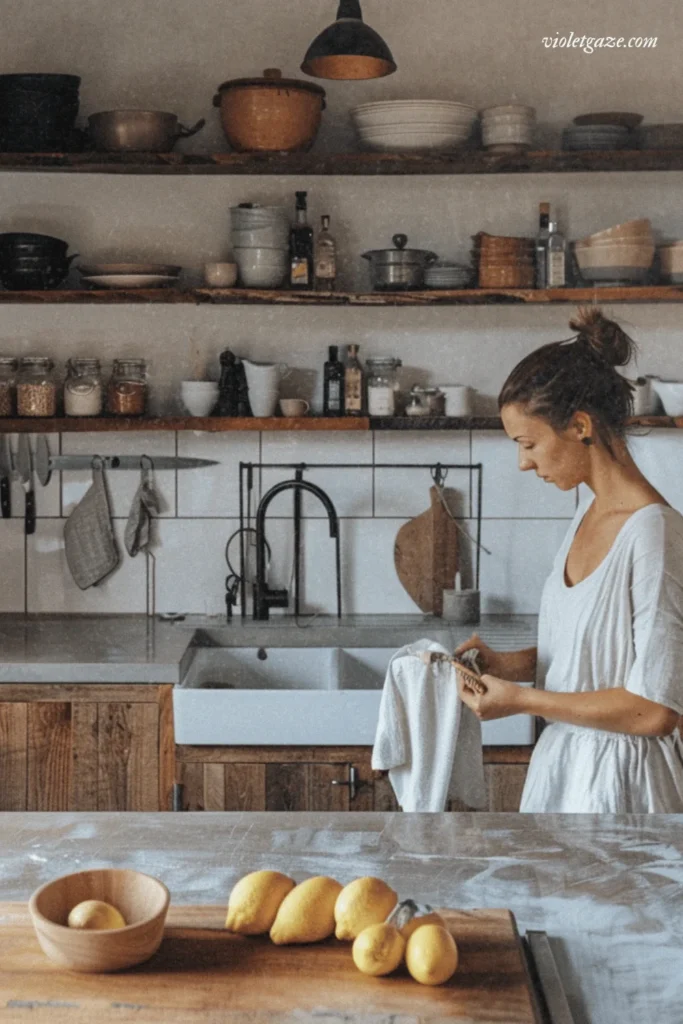
My Favorite Eco-Friendly Brands.
I’ve already mentioned some of my favorite brands for a nontoxic home, but here’s a little additional round-up of the best nontoxic home products we use since it can be really tricky to filter these brands out yourself:
Sabai
A sustainable furniture brand that uses recycled materials, preventing off-gassing from newly created materials while providing all parts of a couch from the inserts to the covers for a “repair, don’t replace” practice.
Our Place
These beautiful pots, pans, and other cooking tools and accessories have a beautiful matte look while being nontoxic and nonstick. I went full-out and replaced the majority of our Teflon cookware with Our Place and it really elevates the look and ease of our kitchen.
Caraway
Caraway is another brand that has non-toxic cookware that’s safe for cooking. Their cookware is made from ceramic, and doesn’t have harmful chemicals like PFOA and PTFE found in traditional nonstick coatings.
Branch Basics
The multi-use concentrate will last you a long time so you can always feel like you’re stocked up on whenever you need it.
Bluecorn
Bluecorn creates natural candles and home products free from synthetic fragrances and chemicals. Many of their candles are made from natural beeswax, which burns cleanly and has a subtle, natural scent.
They also don’t process their candles with any solvents, phthalates, or anything from California’s Prop 65 list. The beeswax burns cleanly and has a subtle, natural scent that is not overpowering.
Plus, I love that I can enjoy candles in my home without having to worry about breathing in harmful chemicals.
ThredUp
ThredUp has a huge selection of brand-name, gently used clothing. Shopping with ThredUp not only helps reduce textile waste but also allows you to find unique and stylish pieces for your wardrobe.
I recently started shopping on ThredUp and am so happy with what I’ve gotten! I was nervous because I couldn’t try anything on, but I was so happy with my purchase. Plus, I always feel good knowing that I’m supporting a more circular fashion economy.
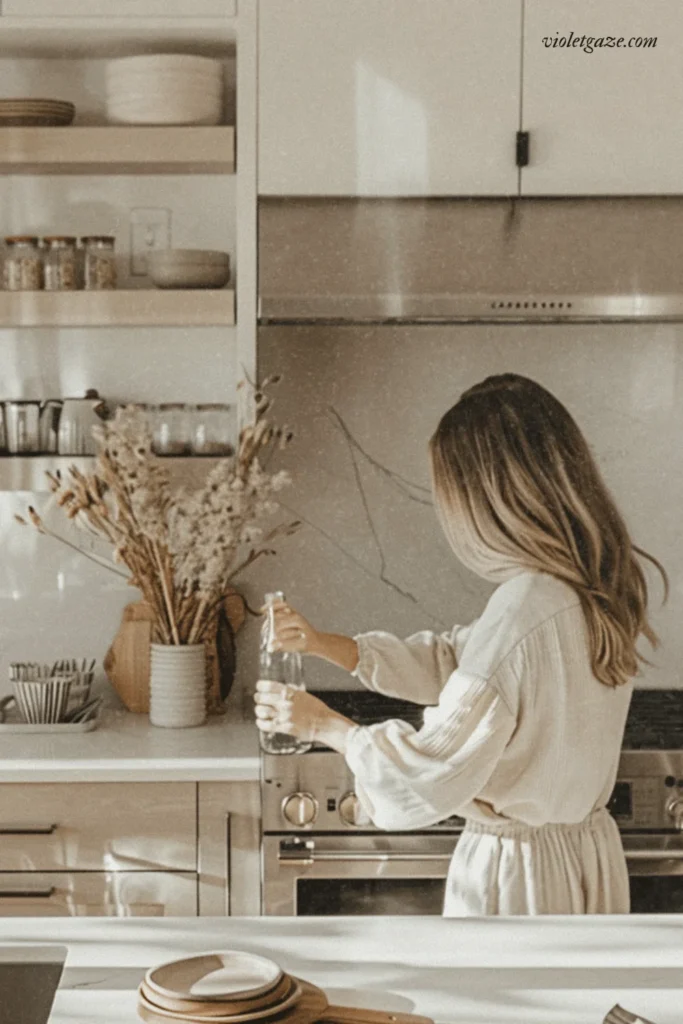
Nontoxic Home: Frequently Asked Questions
What is Off-Gassing?
Off-gassing refers to the release of chemicals from products into the air. Many household items, such as furniture, carpets, and paint, can off-gas volatile organic compounds (VOCs), which can have negative health effects.
I avoid off-gassing products as much as possible because long-term exposure to VOCs respiratory issues, headaches, and other health problems.
Examples of products that commonly off-gas include:
- New furniture, especially those made from composite wood products
- Carpets and rugs
- Paints and varnishes
- Cleaning products
- Mattresses and bedding
To reduce your exposure to off-gassing in your home, consider the following tips:
- Choose products that are low-VOC or VOC-free.
- Air out new products in a well-ventilated area before bringing them into your home.
- Use an air purifier with a HEPA filter to help remove VOCs from the air.
- Avoid smoking indoors and using harsh cleaning products that contain VOCs.
How to Check If Something is Organic?
When it comes to organic products, it’s important to look for certifications from reputable organizations. Organic certifications ensure that products meet specific standards for organic production, which can vary depending on the product.
To identify organic products, look for labels or certifications from organizations such as:
- USDA Organic: For food and agricultural products
- GOTS (Global Organic Textile Standard): For textiles and clothing
- OEKO-TEX: For textiles and clothing, indicating that they are free from harmful substances
- COSMOS (Cosmetic Organic Standard): For organic cosmetics and personal care products
You can also read product labels to identify organic ingredients. Look for ingredients that have the organic label and check for the percentage of organic ingredients in the product.
*Please note: a product having an organic label doesn’t always mean the food doesn’t have things like heavy metals. We also trust food that’s not organic but third-party tested. For example, AG1 by Athletic Greens isn’t technically organic, but because it’s third-party tested, we trust it!
How to Know What Brands Are Nontoxic?
The key is brand transparency.
Brands that focus on being nontoxic usually have pages on their websites dedicated to their nontoxic mission. This might also include a list of their ingredients, and/or a breakdown of their process.
Achieving more nontoxic homes simply means being more stringent on the brands you trust.
The long-term health benefits for you and your fellow home dwellers of living a more intentional life will be worth it!
Now that you have a nontoxic home, let’s find your best natural deodorant so your home and body can be free of toxic chemicals.
Paragraph
Paragraph
Creative lifestyle
Creative lifestyle
Creative lifestyle
Paragraph
Xo, Kira Violet
I'm an artist at heart, performer and songwriter, and a lover of all things creatively & artistically beautiful. In this little corner of the internet, we talk about how to live an artistic lifestyle, fit with the tools, techniques, tips, and community. Get comfy and cozy.
BACK TO THE BLOG
I'll pass you little notes full of my latest musings, tips & fav creative tools for being your best artist.







